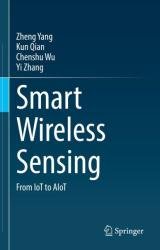Smart Wireless Sensing: From IoT to AIoT
- Добавил: literator
- Дата: 24-12-2021, 21:19
- Комментариев: 0
 Название: Smart Wireless Sensing: From IoT to AIoT
Название: Smart Wireless Sensing: From IoT to AIoTАвтор: Zheng Yang, Kun Qian, Chenshu Wu
Издательство: Springer
Год: 2021
Страниц: 238
Язык: английский
Формат: pdf (true)
Размер: 11.3 MB
Perception of human beings has evolved from natural biosensor to powerful sensors and sensor networks. In sensor networks, trillions of devices are interconnected and sense a broad spectrum of contexts for human beings, laying the foundation of Internet of Things (IoT). However, sensor technologies have several limitations relating to deployment cost and usability, which render them unacceptable for practical use. Consequently, the pursuit of convenience in human perception necessitates a wireless, sensorless and contactless sensing paradigm.
Recent decades have witnessed rapid developments in wireless sensing technologies, in which sensors detect wireless signals (such as acoustic, light, and radio frequency) originally designed for data transmission or lighting. By analyzing the signal measurements on the receiver end, channel characteristics can be obtained to convey the sensing results. Currently, significant effort is being devoted to employing the ambient Wi-Fi, RFID, Bluetooth, ZigBee, and television signals for smart wireless sensing, eliminating the need for dedicated sensors and promoting the prospect of the Artificial Intelligence of Things (AIoT).
This book provides a comprehensive and in-depth discussion of wireless sensing technologies. Specifically, with a particular focus on Wi-Fi-based sensing for understanding human behavior, it adopts a top-down approach to introduce three key topics: human detection, localization, and activity recognition. Presenting the latest advances in smart wireless sensing based on an extensive review of state-of-the-art research, it promotes the further development of this area and also contributes to interdisciplinary research.
Organization of the Book:
The monograph begins with an introductory Part I, which consists of two chapters. Chapter 1 first presents the basic concept of wireless sensing, with emphasis on the wireless signals used for sensing. Then, it demonstrates some typical application scenarios of wireless sensing including smart home, security surveillance, and vital or biometrics recognition. At last, three challenges that hinder the development of wireless sensing are discussed. Chapter 2 presents the readers with some preliminary knowledge on Wi-Fi-based wireless sensing, which is the main wireless sensing modality discussed in this monograph. First, this chapter introduces the definition of channel state information (CSI) that has been commonly used for Wi-Fi sensing. Then, to give the readers a comprehensive understanding of CSI, the measurement noise in CSI is elaborated as well as some representative signal features. At last, some platforms that support CSI extraction are introduced.
Part II to Part IV study different granularity human behaviors, from existence detection to localization to activity recognition.
Part II discusses the technology of human detection with Wi-Fi signals. This technology is used to detect if there are humans in the sensing area and is often applied in security surveillance scenarios. From Chaps. 3 to 5, we exploit the amplitude and phase information of CSI signals to characterize human existence. By exploiting the correlation between the CSI phase and human motion, we present techniques to mitigate the impact of environmental diversities and try to enhance the system’s robustness. Besides, we propose to leverage human respiration motions for static human detection.
Part III discusses the technology of human localization with Wi-Fi signals. This technology is used to track the precise location of the human body and is often applied in smart home and security surveillance scenarios. In Chap. 6, we establish a quantitative relationship between Doppler Frequency Spectrum (DFS) and the moving speed of the reflection point. By extracting DFS from CSI signals of multiple Wi-Fi links, we can obtain the location of the target user. In Chap. 7, we introduce the techniques to perform localization with a single Wi-Fi link. Specifically, we propose methods to extract the DFS, Angle of Arrival (AoA), and Time of Flight (ToF) features simultaneously to portray the motion status of the user and eventually obtain the localization results.
Part IV discusses the technology of human activity recognition with Wi-Fi signals. This technology is used to perceive the types of human activities and is often applied for human-computer-interaction. From Chaps. 8 to 10, we study four cases including moving direction estimation, gesture recognition, gait recognition, and fall detection. We pay particular attention to the environmental-dependent and data-dependent problems and propose novel solutions to tackle them. In the last part (Part V), we conclude the monograph and point some research directions in the wireless sensing field.
Скачать Smart Wireless Sensing: From IoT to AIoT
Внимание
Уважаемый посетитель, Вы зашли на сайт как незарегистрированный пользователь.
Мы рекомендуем Вам зарегистрироваться либо войти на сайт под своим именем.
Уважаемый посетитель, Вы зашли на сайт как незарегистрированный пользователь.
Мы рекомендуем Вам зарегистрироваться либо войти на сайт под своим именем.
Информация
Посетители, находящиеся в группе Гости, не могут оставлять комментарии к данной публикации.
Посетители, находящиеся в группе Гости, не могут оставлять комментарии к данной публикации.
